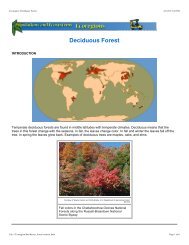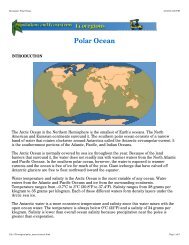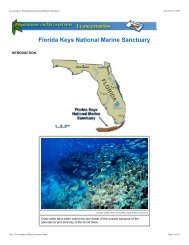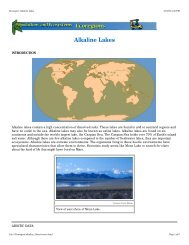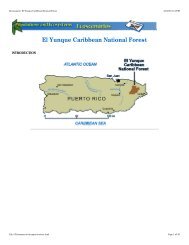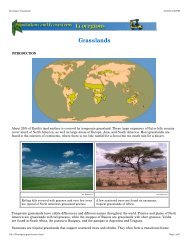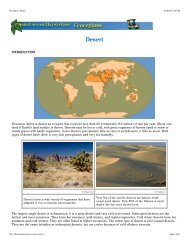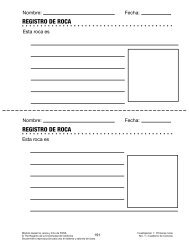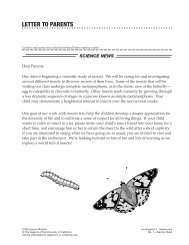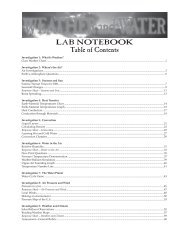Ecoscenarios Combined - FOSSweb
Ecoscenarios Combined - FOSSweb
Ecoscenarios Combined - FOSSweb
Create successful ePaper yourself
Turn your PDF publications into a flip-book with our unique Google optimized e-Paper software.
Ecoscenario: Mono Lake<br />
4/16/03 3:18 PM<br />
In 1941 Los Angeles began diverting water from the freshwater streams that feed Mono Lake. Aquaducts carried the water 563 kilometers<br />
(352 miles) to a rapidly growing city. Changes to the lake were dramatic. Without a freshwater source the salinity of the lake doubled. By<br />
1995 the water level had dropped over 13.7 meters (45 feet).<br />
Even though it looks barren and deserted at first glance, Mono Lake is actually one of the most productive ecosystems on the continent.<br />
Below the water's surface a huge population of algae is the base of a food chain. Massive populations of brine shrimp and brine flies feed<br />
on the algae. These crustaceans and insects in turn provide nourishment for populations of birds that come to Mono Lake from as far<br />
away as the Arctic Circle and the equator. Millions of birds visit Mono Basin between midsummer and fall, feasting on the abundant food<br />
and nesting on the protected islands.<br />
ABIOTIC DATA<br />
Mono Lake, the largest lake completely in California, covering 183 square kilometers (70.5 square miles), sits in a broad, shallow basin<br />
with no outlet. Water flows into the lake from several small freshwater streams, but no water ever flows out. Fresh water picks up minute<br />
amounts of salt in its journey to the basin, and the only way out for the water is through evaporation. Consequently, over the years salt<br />
has built up in the lake. Mono Lake basin is an active volcanic area. The two islands, Negit and Paoha, are actually small volcanic cinder<br />
cones sticking out of the lake. Paoha, larger of the two cinder cones, still spouts steam from vents, and there are several hot springs on<br />
the island as well.<br />
Courtesty of Teri Dannenberg<br />
Negit Island is the exposed top of a volcanic cinder<br />
cone.<br />
Courtesy of the Mono Lake Committee<br />
David Gaines demonstrates that floating in the superalkaline<br />
water is almost effortless.<br />
Salt<br />
The most important abiotic factor in Mono Lake is high salt content. In fact, Mono Lake contains about 280 million tons of dissolved<br />
salts. These salts are composed of many different salts, one of which is sodium chloride or table salt. This makes the water alkaline.<br />
Alkaline water is basic (as opposed to acidic). The alkali salts raise the pH to about 10, and the water feels slippery between your<br />
fingers. If you wanted to make your own Mono Lake water at home, you would stir up this recipe.<br />
37 ml sodium chloride (table salt)<br />
67 ml sodium bicarbonate (baking soda)<br />
10 ml magnesium sulfate (Epsom salt)<br />
a pinch of sodium borate (borax)<br />
a pinch of phosphate (detergent)<br />
1 liter water<br />
Light and temperature<br />
Mono Lake is wedged between the Great Basin (a high desert) and the Sierra Nevada at an elevation of about 2000 meters (6560 feet).<br />
At this elevation winter temperatures are cold, rarely going over 5°C (41°F) during the day and plunging to –8°C (18°F) at night. Days are<br />
short during the winter, with only 9 hours of light on December 21, the winter solstice.<br />
During the summer, temperatures are generally pleasant, averaging 28°C (82°F) for highs and falling to 9°C (48°F) at night. The longest<br />
summer days are 15 hours long.<br />
file:///Ecoscenario/mono/content.html<br />
Page 3 of 11



